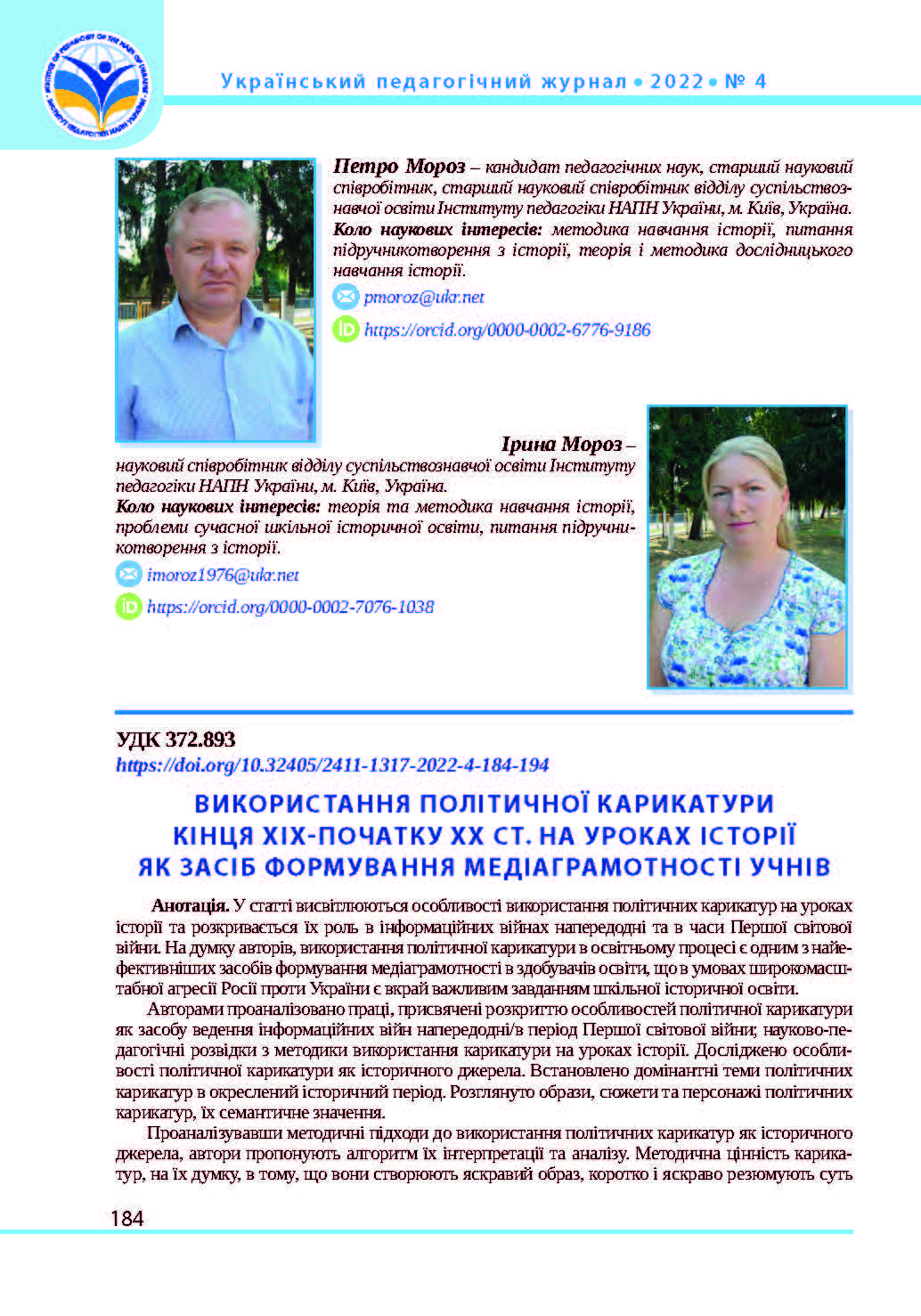Abstract
The article highlights the peculiarities of the use of political cartoons in history lessons and reveals their role in information wars on the eve and during the First World War. According to the authors, the use of political cartoons in the educational process is one of the most effective means of forming media literacy in students, which in the conditions of large-scale Russian aggression against Ukraine is an extremely important task of school history education.
The authors analyzed the works dedicated to revealing the features of political caricature as a means of conducting information wars on the eve/during the First World War; scientific-pedagogical research on the methodology of using caricatures in history lessons. Peculiarities of the political caricature as a historical source are studied. The dominant themes of political cartoons in the outlined historical period are established. The images, plots and characters of political caricatures, and their semantic meaning are considered.
Having analyzed methodical approaches to the use of political cartoons as a historical source, the authors propose an algorithm for their interpretation and analysis. The methodological value of caricatures, in their opinion, is that they create a bright image, briefly and vividly summarize the essence of a historical or social phenomenon or event. The article presents samples of research tasks on the analysis of political caricatures of the specified period.
The conducted research does not exhaust all aspects of the problem of using political caricature as a means of forming media literacy of students of general secondary education. According to the authors, further research is needed to study the caricature as an important visual tool for the formation of public opinion in other historical periods.
References
Бакка, Т., Волошенюк, О., Гуменюк, Л., Євтушенко, Р., Мелещенко, Т., Мокрогуз, О., & Потапова, В. (2016). Медіаграмотність на уроках суспільних дисциплін . Центр вільної преси, Академія вільної преси.
В умовах війни медіаграмотність повинна стати необхідним і обов’язковим елементом повсякденного життя. (2022, 4 липня). Урядовий портал. https://www.kmu.gov.ua/news/v-umovah-vijni-mediagramotnist-povinna-stati-neobhidnim-i-obovyazkovim-elementom-povsyakdennogo-zhittya
Власюк, А. (2015). Антиросійська політична карикатура в Україні як засіб пропаганди у період військового протистояння на Сході України у 2014‒2015 роках. Масова комунікація: історія, сьогодення, перспективи. 7‒8 (6), 9–13.
Ковінько, К. (2012). Жанр політичної карикатури: функціональні, дискурсивні та стилістичні особливості. Вісник Харківського національного університету ім. В.Н. Каразіна, 70. Серія: Романо-германська філологія. Методика викладання іноземних мов. (70), 96–101.
Комаров, Ю. (2004). Запам’ятовується назавжди! (З практики використання політичних карикатур у шкільному викладанні історії). Історія в школах України, (1), 15–20.
Куцик, Р. (2017). Карикатура як особливий механізм інформаційної пропаганди на території українських губерній південно-західного краю у 1914–1917 рр. Наукові праці історичного факультету Запорізького національного університету, (47), 86–91.
Маєвський, О. (2018). Політичні плакат і карикатура як засоби ідеологічної боротьби в Україні 1939–1945 рр. Інститут історії України НАН України.
Малієнко, Ю. (2019). Теоретичні засади візуалізації змісту підручників з історії для старшої школи у контексті компетентнісного навчання. Проблеми сучасного підручника, (23), 149 161.
Мороз, П., & Мороз, І. (2018). Дослідницька діяльність учнів у процесі навчання всесвітньої історії в основній школі: методичний посібник. ТОВ «КОНВІ ПРІНТ».
Мороз, П. (2022). Розкриття ролі карикатур в інформаційних війнах ХХ – початку ХХІ ст. засобами шкільного підручника історії. У Проблеми сучасного підручника: навчально-методичне забезпечення освітнього процесу в умовах воєнного часу . Київ: Педагогічна думка, 295–299.
Мороз, П., Мороз, І., & Власов, В. (2021). Історія України в джерелах. ТОВ «КОНВІ ПРІНТ».
Питльована, Л. Ю. (2014). Антибританська політична карикатура у Німеччині як засіб пропаганди у період Першої світової війни. Вісник Національного університету "Львівська політехніка", (784), 76–84.
Питльована, Л. Ю., & Бураков, Я. Ю. (2019). УКРАЇНА, РОСІЯ І СВІТОВА БЕЗПЕКА У КАРИКАТУРІ ДЕРІЛА КЕЙГЛА ТА ІНТЕРНЕТ-РЕСУРСУ CAGLE CARTOONS. Військово-науковий вісник, (31), 206–224.
Пометун, О., & Фрейман, Г. (2007). Методика навчання історії в школі. Генеза.
Почепцов, Г. (2013). Смислові та інформаційні війни. Інформаційне суспільство, (18), 21–27.
Семотюк, О. (2015). Українсько-російська війна у політичних карикатурах США, ФРН та України: досвід кількісного і якісного аналізу. Збірник праць Науково-дослідного інституту пресознавства, (5 (23)), 251–261.
Філатова, М. (2014). Політична карикатура Джеймса Гіллрея (1757‒1815) з колекції Харківського художнього музею. Вісник Харківської державної академії дизайну і мистецтв. Мистецтвознавство. Архітектура, (3), 96–101.

This work is licensed under a Creative Commons Attribution-NonCommercial-ShareAlike 4.0 International License.


